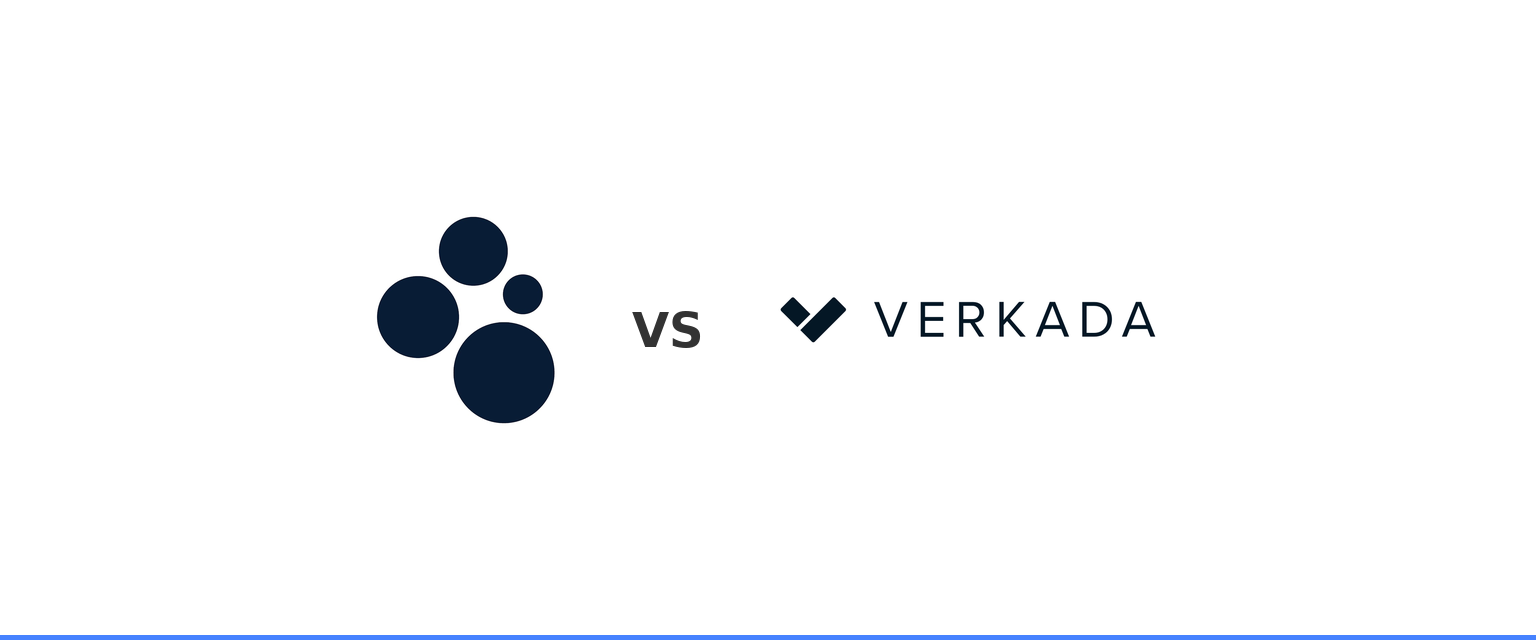When organizations evaluate video security platforms in 2025, the decision often comes down to choosing between specialized operational intelligence solutions and broader physical security suites.
Spot AI and Verkada represent two different approaches to this challenge, each with specific strengths that serve different organizational priorities. Verkada positions itself as an all-in-one physical security platform for large enterprises. It serves over 27,000 customers with an integrated ecosystem that includes video security, access control, workplace management, and air quality monitoring. The system also features alarms and intercoms, all managed through their cloud-based Command platform.
This comparison examines how these two platforms stack up across the criteria that matter most to B2B decision-makers: deployment flexibility, AI capabilities, total cost of ownership, and operational impact.
Platform architecture: Camera flexibility vs proprietary ecosystem
The fundamental architectural difference between Spot AI and Verkada shapes every aspect of deployment, cost, and scalability. This platform architecture influences how organizations can leverage their existing infrastructure and plan for future growth.
Hardware requirements and compatibility
Aspect |
Spot AI |
Verkada |
|---|---|---|
Camera compatibility |
Works with any IP camera supporting RTSP, regardless of manufacturer |
Requires proprietary Verkada cameras exclusively |
Existing infrastructure |
Preserves and enhances current camera investments |
Requires complete camera replacement |
Hardware costs |
No mandatory camera purchase; integrates with existing hardware |
Significant upfront hardware investment per camera |
Deployment approach |
Software overlay on existing systems |
Full hardware and software replacement |
Vendor flexibility |
Supports 100+ camera brands |
Tied to a single hardware vendor |
Deployment speed and complexity
Organizations with existing camera infrastructure face significantly different implementation timelines. Spot AI's camera-agnostic approach allows for rapid deployment for most systems, as the platform automatically discovers and configures compatible cameras on the network. Teams can begin extracting value from their video data without disrupting operations or waiting for hardware installations.
Verkada's approach requires scheduling hardware replacements, potentially causing operational disruptions during the transition period. While the company emphasizes plug-and-play installation with a 9.9/10 ease of setup rating, this applies only after the physical camera replacement process is complete.
AI capabilities: Operational intelligence vs basic detection
The depth and specificity of video AI capabilities determine whether a video platform can deliver operational improvements or general security monitoring. This comparison reveals how each platform approaches video analysis.
Video AI feature comparison
AI Capability |
Spot AI |
Verkada |
|---|---|---|
Forklift safety |
Forklift Enters No-go Zones |
Offers people and vehicle analytics |
PPE compliance |
Missing PPE detection with real-time alerts |
Feature not listed in public documentation |
Time studies |
Automated time studies for process optimization |
Feature not listed in public documentation |
SOP adherence |
Changeover SOP Adherence tracking with performance metrics |
No native feature for this use case |
Vehicle monitoring |
Vehicle Enters No-go Zones with specific zone configuration |
Offers people and vehicle analytics |
Operational analytics |
Unattended Workstation, People Absent, Crowding detection |
Focuses on people, vehicle, and motion events |
Search capabilities |
Natural language search, reduces investigation time by up to 80% vs. manual review |
Attribute-based search (e.g., clothing color) |
Pre-trained AI agents vs generic detection
Spot AI's pre-trained AI Agents target specific operational challenges across manufacturing, construction, and retail environments. For manufacturing facilities, the platform can identify when vehicles enter restricted areas, helping to prevent incidents, while construction sites benefit from automated PPE compliance monitoring that strengthens contractor accountability.
Verkada's AI capabilities center on "activity detection leveraging AI" without specification of particular event types or operational scenarios. This approach limits the platform's ability to address industry-specific safety and compliance requirements that improve safety and efficiency.
Operational impact metrics
The practical difference in AI capabilities translates directly to operational results. Spot AI customers report an 80% reduction in incident investigation time, converting half-day review processes into resolutions completed in minutes. The platform's SOP Adherence solution helps manufacturing teams standardize best practices across shifts, creating "Gold-Standard" SOPs from highest-performing runs.
Total cost of ownership: A pricing model comparison
Understanding the true cost of a video security platform extends beyond initial licensing fees to encompass hardware requirements, deployment services, and ongoing operational expenses. The pricing models of these platforms reflect their different approaches to market.
Cost model comparison
Cost Component |
Spot AI |
Verkada |
|---|---|---|
Camera hardware |
No mandatory camera purchase; integrates with existing hardware |
Significant upfront hardware investment per camera |
Software licensing |
Tiered pricing model available |
Per-camera license fee required, with multi-year term options |
Installation services |
Minimal (software-only deployment) |
Installation often handled by certified reseller partners |
Training costs |
Self-service with dedicated support |
Varies by reseller and support plan |
Network infrastructure |
Leverages existing network |
Dependent on existing network infrastructure capacity |
Storage options |
Flexible cloud/edge hybrid |
Onboard camera storage + cloud |
Expansion costs |
Add licenses to existing cameras |
Purchase new cameras + licenses |
Integration ecosystem: Open platform vs closed system
Modern enterprises require video platforms that integrate with existing operational systems, from access control to environmental monitoring. The integration philosophy of each platform significantly impacts its ability to serve as a central component of a company’s technology strategy.
Platform openness and extensibility
Integration Feature |
Spot AI |
Verkada |
|---|---|---|
API availability |
Open APIs for custom integration |
API available for integration with select third-party systems |
Third-party cameras |
100+ supported brands |
None - proprietary only |
Access control |
Avigilon Alta integration |
Native access control product |
Environmental sensors |
HALO Smart Sensor integration |
Air quality monitoring included |
SSO providers |
Google, Microsoft, Okta |
SAML 2.0 support for Okta, Azure AD, and other providers |
POS systems |
Supported through open architecture |
No native feature for this use case |
Custom workflows |
Supported via APIs |
Customization focused within the Verkada ecosystem |
Workflow automation potential
Spot AI's open architecture allows organizations to create custom workflows that connect video events to existing business systems. When the platform detects an unattended workstation in manufacturing, it can automatically trigger notifications in production management systems or update live dashboards. This extensibility converts video from an isolated security tool into an integrated operational analysis platform.
Verkada's closed ecosystem approach prioritizes internal integration between its own products. While this creates a unified experience within the Verkada suite, it can limit the platform's ability to integrate with specialized, external industry systems.
Industry-specific applications: Tailored solutions vs generic security
Manufacturing optimization
Manufacturing facilities using Spot AI leverage specific AI agents designed for production environments:
Changeover SOP Adherence: Tracks procedure compliance step-by-step, benchmarking performance across shifts
Process Bottleneck Detection: Identifies and quantifies wait times or slowdowns in production lines to support continuous improvement efforts
Missing PPE: Helps support OSHA compliance around dangerous machinery
Unattended Workstation: Identifies production bottlenecks and equipment downtime
Verkada's manufacturing capabilities focus on general security monitoring without specific production optimization features.
Construction site management
Construction companies require dynamic monitoring solutions that adapt to changing site conditions:
Requirement |
Spot AI Solution |
Verkada Approach |
|---|---|---|
Contractor compliance |
Automated PPE detection for all workers |
Relies on live viewing or post-event review |
Dynamic zones |
Vehicle/Person Enters No-go Zones with adjustable boundaries |
Line-crossing and motion-based alerts |
Incident documentation |
Accelerated investigation with timestamped evidence |
Timeline-based video review |
Multi-site visibility |
Unified dashboard across all projects |
Centralized Command platform |
Retail and distribution centers
Retail operations and distribution centers benefit from specialized monitoring that addresses both security and operational efficiency. Spot AI offers targeted solutions like dwell time analysis for optimizing store layouts and crowding analysis for streamlining picking/packing workflows. The platform's Unattended Checkout monitoring helps reduce customer wait times while maintaining service quality.
Customer support and success models
The quality of ongoing support significantly impacts the long-term value organizations derive from their video platform investment. Both companies approach customer success differently, reflecting their target markets and deployment complexity.
Support comparison
Support Feature |
Spot AI |
Verkada |
|---|---|---|
Availability |
Monday-Friday 9AM-9PM ET |
24/7 professional monitoring for alarm events |
Support location |
U.S.-based human support |
Varies by reseller and support plan |
Customer Success Manager |
Dedicated CSM for enterprise clients |
Varies by reseller and support plan |
Implementation assistance |
Guided self-installation |
Professional installation services |
Response quality |
Praised by customers for responsive, U.S.-based support (Source: Capterra) |
Support is delivered through a network of reseller partners |
Customer testimonials on sites like Capterra highlight Spot AI's support quality as a key differentiator, with users praising the responsive, U.S.-based team.
Scalability and multi-site operations
Organizations planning multi-location deployments must consider how each platform scales across distributed operations while maintaining centralized visibility and control.
Multi-site deployment comparison
Spot AI's software-centric model is well-suited for multi-site scenarios where camera infrastructure varies by location. Companies like Bridge33 standardize video security across existing and newly acquired assets, regardless of installed camera types. This flexibility is valuable during mergers, acquisitions, or rapid expansion.
Verkada's unified Command platform offers centralized management across multiple sites, but it requires standardizing on Verkada hardware at each location. While this creates a uniform setup, it also increases deployment costs and timelines for organizations with diverse existing infrastructure.
Bandwidth and storage optimization
Spot AI: Hybrid edge-cloud architecture processes video locally on NVIDIA GPU-powered video recorders, transmitting only relevant events to the cloud
Verkada: Onboard camera storage with cloud management; bandwidth usage varies based on cloud feature configuration
For bandwidth-constrained locations, Spot AI's edge processing model reduces network requirements while maintaining AI capabilities.
Making the right choice for your organization
The decision between Spot AI and Verkada ultimately depends on your organization's specific priorities, existing infrastructure, and operational goals.
When to choose Spot AI
Have existing camera infrastructure you want to preserve and enhance
Require specific operational AI capabilities like PPE compliance or SOP adherence monitoring
Need open APIs for integration with existing business systems
Operate in manufacturing, construction, or retail with specific safety and efficiency goals
Want predictable, transparent pricing without hardware lock-in
Value rapid deployment without operational disruption
When Verkada makes sense
Prefer single-vendor solutions for all physical security needs
Are undertaking complete security system replacements
Want a single platform for video security, access control, and air quality monitoring
Have dedicated installation budgets for new hardware
Industry-specific recommendations
Manufacturing and warehousing: Spot AI's operational focus, SOP adherence tracking, and process optimization capabilities help address production efficiency and safety compliance needs.
Construction: The flexibility to work with temporary camera setups and specific PPE/zone violation detection makes Spot AI more suitable for dynamic construction environments.
Multi-site retail: Organizations with varied camera infrastructure benefit from Spot AI's ability to standardize operations without hardware replacement.
Single-site offices: Verkada's integrated security suite offers coverage for organizations seeking basic monitoring without operational analytics requirements.
Explore Spot AI
See how Spot AI’s video AI platform works with your current cameras to support safety, compliance, and operational goals. Request a demo to view the platform in action, or review real-world results in our customer stories.
About the author
Tomas Rencoret leads the Growth Marketing team at Spot AI, where he helps safety and operations teams use video AI to cut safety and security incidents as well as boost productivity.

























.png)
.png)
.png)